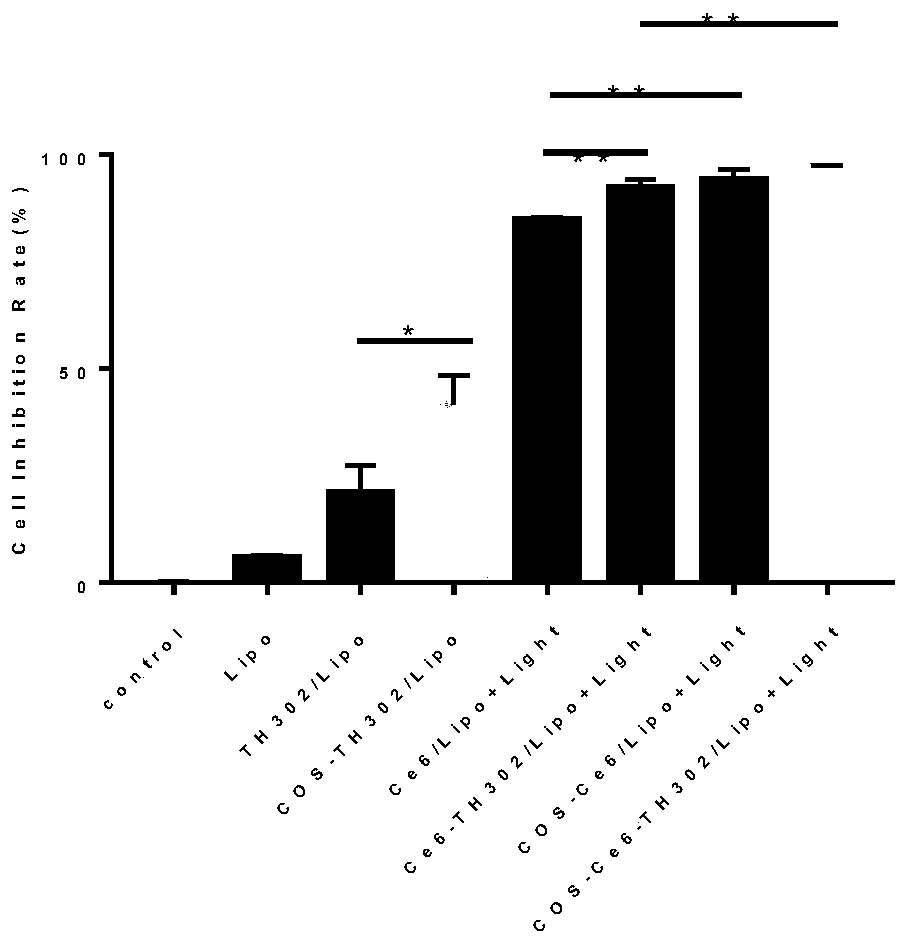A photosensitive nano-liposome targeting triple-negative breast cancer stem cells
A triple-negative breast cancer, nano-liposome technology, applied in the direction of liposome delivery, organic active ingredients, medical preparations of non-active ingredients, etc. Tumor drugs, lack of targeting, etc., to increase the therapeutic effect, solve the toxic and side effects, and achieve the effect of good stability
- Summary
- Abstract
- Description
- Claims
- Application Information
AI Technical Summary
Problems solved by technology
Method used
Image
Examples
Embodiment 1
[0045] Embodiment 1: The preparation method of the photosensitive nanoliposome targeting triple-negative breast cancer stem cells comprises the following steps:
[0046](1) Measure 80mL of methanol, add 0.065g of EDC and 0.039g of NHS under stirring conditions, then add 0.3mL of oleic acid, and fully stir for 30min to obtain the first mixed solution;
[0047] (2) Weigh 1 g of chitosan oligosaccharide and dissolve it in 100 mL of 1% acetic acid solution to obtain the second mixed solution;
[0048] (3) Add the first mixed solution dropwise to the second mixed solution, stir and react at room temperature for 48 hours to obtain the third mixed solution;
[0049] (4) A small amount of ammoniacal liquor is added to the third mixed solution to separate out the precipitate, centrifuged, the centrifugal speed is 3000rmp, and the centrifugal time is 5min, thoroughly washed with methanol, dialyzed in distilled water for 48h, and the distilled water used for dialysis is replaced every 4h...
Embodiment 2
[0053] Example 2: Characterization of photosensitive nanoliposomes targeting triple-negative breast cancer stem cells
[0054] 1) TEM detection:
[0055] The photosensitive nano-liposome targeting triple-negative breast cancer stem cells was taken, dropped on the copper grid, and observed under TEM after drying.
[0056] 2) Nanoparticle size analysis:
[0057] The photosensitive nano-liposome targeting triple-negative breast cancer stem cells was placed in a cuvette, and the particle size was measured by a nanoparticle analyzer.
[0058] 3) Encapsulation efficiency detection of photosensitive nanoliposomes targeting triple-negative breast cancer stem cells
[0059] UV-visible spectrophotometer was used to measure: ① prepare standard solutions of TH302 and Ce6, and detect the OD values of different concentrations of TH302 and Ce6 at wavelengths of 330nm and 500nm; ② freeze-dry targeted photosensitive nano-lipids and dissolve them in methanol After centrifuging to take the ...
Embodiment 3
[0064] Example 3: In vitro treatment of photosensitive nanoliposomes targeting triple negative breast cancer stem cells
[0065] 1) CCK8 experiment
[0066] ①The cells were divided into culture medium group, simple chemotherapy group (photosensitive liposomes loaded with Ce6 and TH302 without irradiation), simple PDT group (liposomes loaded with Ce6 plus irradiation), targeted PDT group (chitooligosaccharide-modified Ce6-loaded liposomes), targeted chemotherapy group (chitooligosaccharide-modified TH302-loaded liposomes), chemotherapy+PDT group (photosensitive liposomes loaded with Ce6 and TH302 plus irradiation), targeted chemotherapy+PDT group (chitooligosaccharide-loaded liposomes) Sugar-modified Ce6 and TH302 liposomes plus irradiation), set the PDT treatment power to 50mW, 30min; ② After the treatment, centrifuge to discard the supernatant, 10μl CCK8, continue to incubate for 4h, then centrifuge to discard the liquid, and use enzyme-labeled The OD value of the cells was ...
PUM
| Property | Measurement | Unit |
|---|---|---|
| particle diameter | aaaaa | aaaaa |
Abstract
Description
Claims
Application Information
 Login to View More
Login to View More - R&D
- Intellectual Property
- Life Sciences
- Materials
- Tech Scout
- Unparalleled Data Quality
- Higher Quality Content
- 60% Fewer Hallucinations
Browse by: Latest US Patents, China's latest patents, Technical Efficacy Thesaurus, Application Domain, Technology Topic, Popular Technical Reports.
© 2025 PatSnap. All rights reserved.Legal|Privacy policy|Modern Slavery Act Transparency Statement|Sitemap|About US| Contact US: help@patsnap.com



